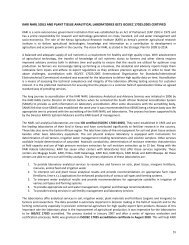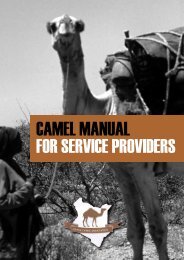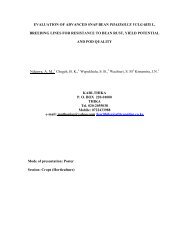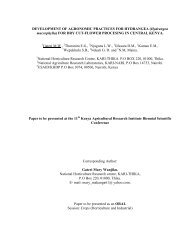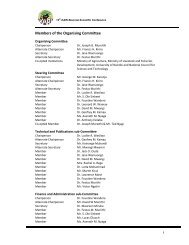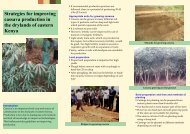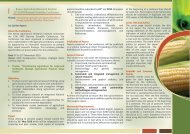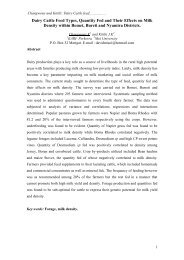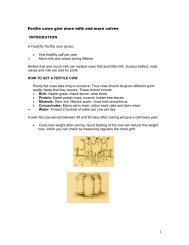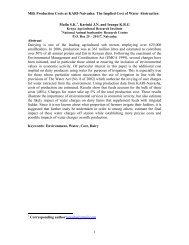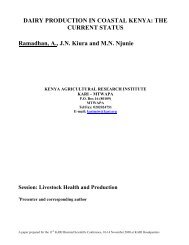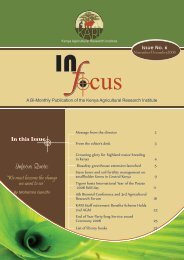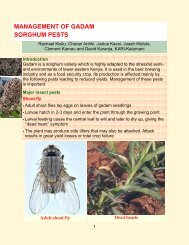indigenous fodder plants - Kenya Agricultural Research Institute
indigenous fodder plants - Kenya Agricultural Research Institute
indigenous fodder plants - Kenya Agricultural Research Institute
You also want an ePaper? Increase the reach of your titles
YUMPU automatically turns print PDFs into web optimized ePapers that Google loves.
INDIGENOUS FODDER PLANTS: THE UNDERUTILIZED FEED RESOURCE<br />
J. N. N. Kang’ara 1 , I. W. Kariuki, E.M. Kiruiro, S.C. Amboga and I.N. Mwangi<br />
KARI-Embu, P.O. Box 27-60100, Embu, KENYA. Tel: 068-31116/31873; Fax: 068-30064<br />
1<br />
Corresponding author E-mail : johnkangara@yahoo.com, or kariembu@salpha.co.ke<br />
Abstract:<br />
Reports on forage research in <strong>Kenya</strong> include exploration and evaluation of <strong>indigenous</strong> forage<br />
<strong>plants</strong> along side forages imported from other countries in the past. Both exotic and <strong>indigenous</strong><br />
<strong>fodder</strong>s were evaluated under local conditions as livestock feed in different agro-ecological<br />
zones. Following this procedure, several ley pastures species used today were domesticated. As<br />
the land sizes declined with increase in population pressure, livestock management system shifted<br />
from grazing animals in the paddocks to zero-grazing in early 1980s. <strong>Research</strong> on forages then<br />
shifted its focus to exotic <strong>fodder</strong> crops with little attention on the <strong>indigenous</strong> <strong>fodder</strong> <strong>plants</strong>. There<br />
was need therefore to generate information on <strong>indigenous</strong> <strong>fodder</strong> <strong>plants</strong> in order to promote their<br />
use in dairy goats and cattle feeding. Dairy goat farmers were asked to select <strong>fodder</strong>s of their<br />
choice from 150 <strong>indigenous</strong> <strong>fodder</strong> species obtained from the previous survey using their own<br />
criteria in addition to their nutritive values. The farmers came up with a list of 26 <strong>indigenous</strong><br />
<strong>fodder</strong> species they preferred to plant in their farms. It was then concluded that; the country has<br />
a wide range of <strong>indigenous</strong> <strong>fodder</strong> <strong>plants</strong> that meets farmers’ selection criteria, only that they<br />
lack the knowledge on many of them. Probably that is why they are underutilized<br />
Introduction:<br />
Traditionally, <strong>indigenous</strong> <strong>fodder</strong> <strong>plants</strong> have been used to feed ruminant animal even before<br />
modern farming. However, there has not been notable effort to cultivate and manage them other<br />
than conserving those that were in existence when the farm was acquired or when the <strong>plants</strong><br />
happen to come up on their own. In <strong>Kenya</strong> exploratory research on <strong>indigenous</strong> forages started in<br />
1932 (Edwards, 1940) and stopped in mid 1970 (Ibrahim and Chabeda 1976). The focus by then<br />
was on pasture production and breeding targeting large and medium scale dairy farms (Boonman<br />
et al., 1976). From that research, ley pastures varieties of Chloris gayana like Pokot Rhodes and<br />
Rongai Rhodes, varieties of Setaria sphacelata like Nandi setaria and many other pasture<br />
species were selected and bred. The research also selected and bred Napier grass, Pennisetum<br />
purpureum one of the oldest <strong>fodder</strong> crop still in use. As land size continued to decline, dairy<br />
production changed from extensive to zero grazing system involving growing <strong>fodder</strong>s such as<br />
Napier grass and tree legumes. The research later shifted its focus to exotic <strong>fodder</strong> crops, since<br />
some information on these <strong>fodder</strong> crops was available from other countries. All they needed was
to conduct adaptive trials in different AEZ of <strong>Kenya</strong> before recommending them for adoption in<br />
our environment. The <strong>fodder</strong>s included Leucaena leucocephala, Desmodium spp, Sesbania<br />
sesban, Gliricidia sepium, Morus alba and Calliandra calothyrsus. Thus, research on <strong>indigenous</strong><br />
<strong>fodder</strong> crops received very little emphasis from researchers. Meanwhile, the popularity of milk<br />
goat rose as from mid 1990s, through the effort of Integrated Small Livestock Project (ISLP).<br />
This was followed by formation of Dairy goat association of <strong>Kenya</strong> (DGAK) and introduction of<br />
Toggenburg breed by FARM-Africa in Meru Central and Tharaka Nithi in 1996 (Garforth et al.,<br />
2006). This change brought in new challenges of feeding dairy goats under confinement as<br />
opposed to free grazing of local goats in the rangeland. Goats browse selectively on a wide range<br />
of species growing in the rangeland. Therefore, they should not be fed on one <strong>fodder</strong> species like<br />
dairy cattle which most of the time, are fed on Napier grass alone under zero-grazing system.<br />
Goats need a number of different plant species for better performance. There is need therefore, to<br />
identify, evaluate and characterize <strong>indigenous</strong> <strong>fodder</strong> <strong>plants</strong> of Mt. <strong>Kenya</strong> region in order to<br />
generate information that could be used by stakeholders to promote research and cultivation of<br />
<strong>indigenous</strong> <strong>fodder</strong> <strong>plants</strong>. This would increase diversity of <strong>fodder</strong> species available for feeding<br />
dairy goats and cattle.<br />
The specific objective of this study was:<br />
• To identify the farmers preference of <strong>indigenous</strong> <strong>fodder</strong> <strong>plants</strong><br />
Methodology:<br />
A survey was conducted to take an inventory of <strong>indigenous</strong> <strong>fodder</strong> <strong>plants</strong> around Mt <strong>Kenya</strong><br />
region. In that survey, <strong>fodder</strong> characteristics and their nutritional potential was observed and<br />
recorded. The survey covered tea and coffee land use zones (UH1-UM1) as well as dry cold<br />
highlands of Kieni West in Nyeri district and, from Tea zone (UH1) to dry lands low marginal<br />
potential (LM3) in Kirinyaga, Embu, Meru south, Meru central, Tharaka and Meru North<br />
districts. It involved making farm visits whereby; farmers were interviewed using a semistructured<br />
questionnaire on the <strong>fodder</strong> used in their farms. While still in the farm, an observation<br />
was made on what was offered to animals on that particular day and from the previous day’s<br />
remains. Samples of new forage species (edible shoots and leaves) were taken for chemical<br />
analysis at the KARI-Embu where the Crude protein (CP) was analyzed using Kjeldahl method.<br />
ADF and NDF were analyzed using ANKOM Technology 1998 Fiber Analyzer while the invitro<br />
dry matter digestibility (IVDMD) was done at the University of Nairobi animal nutrition<br />
laboratories using Tilley and Terry method 1963. The surveys lead to identification of 150
<strong>indigenous</strong> <strong>fodder</strong> species reported earlier (Kang’ara et al., 2007), that were subsequently used in<br />
this study.<br />
In the study, nutritive value results of the 150 <strong>indigenous</strong> species from the previous survey were<br />
sorted and listed in descending order based on their CP percentage content and their IVDMD<br />
percentage. The sorted lists were presented to the dairy goats’ farmers in focused group interview<br />
held in Othaya, Mukurweini and Kiganjo in Nyeri district, Marima in Meru south, Kaguru in<br />
Meru central, Mutuati in Meru North and Irangi in Embu Districts. The dairy goat farmers were<br />
convened for us at different dates and venues by the DGAK. In each meeting, the concept of dry<br />
matter, crude protein and digestibility of <strong>fodder</strong> were explained to farmers before the selection<br />
session. Photographs of some <strong>indigenous</strong> <strong>fodder</strong> <strong>plants</strong> were also shown using computer LCD<br />
projector. Farmers were asked to list the things they look for when selecting a <strong>fodder</strong> they would<br />
prefer to grow in their farms. These criteria were listed in order of their importance in each<br />
location (Table1). Using these criteria and the nutritive value lists presented to them, farmers in<br />
each location were also asked to choose 10 best <strong>fodder</strong>s in order of impotence. The farmers used<br />
elimination Method to select the ten <strong>fodder</strong> species they preferred to plant in their farms whereby<br />
those that did not meet the topmost criteria were dropped first. They were also asked why they<br />
opted not to select some high potential <strong>fodder</strong> species from the nutritional value list we presented<br />
to them.<br />
Results and discussion:<br />
Out of the 150 different <strong>indigenous</strong> <strong>fodder</strong> species fed to animals, about 50 had a crude protein<br />
content ranging from13-34% and IVDMD of 55-90% (Table 2), which put then in a class of high<br />
potential <strong>fodder</strong> like Lucerne and sweet potatoes. This shows that, within the country there is a<br />
wide range of high potential genetic resources that could be tapped to increase <strong>fodder</strong> diversity.<br />
Unfortunately, due to deforestation and over exploitation of these species, many useful species<br />
have gradually disappeared in many areas. Continuous harvesting as has been happening with<br />
Mutoro tree (Celtis gomphophylla), has made some species never to produce seed. This has made<br />
it difficult to propagate Mutoro with seeds. When farmers were asked to choose the <strong>fodder</strong>s they<br />
would like to grow in their farm, they selected through elimination method, in the light of their<br />
nutritive value and out of their experience, 26 out of 150 species presented in Table 2. Of the 26<br />
species selected, 20 were among the top 50 high potential species. Three out of the 26 species<br />
selected by farmers viz; Muga njuki, Triumfetta tomentosa and Cordia africana were from<br />
medium potential while the potential of three others ( Mururi, Murembu and Mukomere) was<br />
unknown. In all the species selected, fattening effect on animal, took prominent consideration in
selection of <strong>fodder</strong>s and was used in selecting about 43% of the species (Figure 1). It is worth<br />
noting that, to farmers fattening meant gaining weight, which could be attributed to good growth<br />
as result of balanced diet. Milk production, palatability and availability of planting materials<br />
were also very important for selection and were each separately used in selection of about 10% of<br />
species. Roothaert and Franzel (2000) reported similar selection criteria of <strong>fodder</strong>s by farmers in<br />
Mbeere and Embu. The biomass production, compatibility with food crops and live fence quality<br />
were important in some areas. The reason for not selecting some of the elite species from the list<br />
was lack of previous knowledge on the species as many farmers saw some of the <strong>fodder</strong>s for the<br />
first time when they were projected on the wall with computer LCD. In addition, even those who<br />
had seen them, doubted whether some plant like Brugmansia aborea (32.6 %CP), and Rumex<br />
usambarensis (34.8 %CP) could be eaten by their animals because of their appearance. A few<br />
farmers thought these two species could be poisonous to animals. These two high potential<br />
species together with Aframomum sp. (Marawa 14.4 % CP and 62.1 % IVDMD) does well in<br />
water logged areas or areas with high rainfall such as upper highland (UH1) tea growing zone.<br />
The three also produce high biomass and are most of time, available as dry season feed. In<br />
addition, Rumex usamabrensis does well in acidic soils and can be grown where Lucerne has<br />
failed to thrive due to low pH. Farmers do not view Muki, Achyrospermum carvalhi with 19.6%<br />
CP and digestibility of 71.1%, which grow as weed in wet highlands, as a <strong>fodder</strong> worth planting<br />
although those who use it praise it for increasing milk production. A few farmers also depicted a<br />
stereo type bias against <strong>indigenous</strong> forages in preference to exotic species.
Figure 1 The important Selection Creteria use frequency (%)<br />
45<br />
40<br />
35<br />
30<br />
Percentage<br />
25<br />
20<br />
15<br />
10<br />
5<br />
0<br />
Palatability<br />
Milk<br />
Fattening<br />
Compatibility<br />
Biomass<br />
Tolerant<br />
Planting<br />
Medicinal<br />
Conservesion<br />
Fence<br />
Criteria<br />
Conclusion and way forward:<br />
1. There is a wide range of <strong>indigenous</strong> <strong>fodder</strong> species in the country that would meet what<br />
farmers look for in the <strong>fodder</strong> of their choice.<br />
2. The information on <strong>indigenous</strong> <strong>fodder</strong> species especially the effect on animals’<br />
performance is lacking in many of the farmers. This is probably why they are<br />
underutilized.<br />
3. <strong>Research</strong> should be done to generate agronomic and animal performance information on<br />
<strong>indigenous</strong> <strong>fodder</strong> <strong>plants</strong><br />
Acknowledgement:<br />
The authors wish to thank Director KARI for allowing this study to be conducted at KARI-Embu<br />
and the Centre Director KARI-Embu for facilitating the studies. The authors also wish to<br />
appreciate the cooperation received from KARI Embu laboratory staff ( Kinga, Arimi, Nyokabi<br />
and Nyaguthie) as well as the university of Nairobi animal production laboratory for nutrient<br />
analysis and the National Museum of <strong>Kenya</strong> Herbarium for species identification. Lastly we wish<br />
to than the DGAK Chairman Nyeri, Meru and Embu for convening the dairy goat formers on for<br />
us.
References:<br />
Edwards D.C. 1940 Pasture and <strong>fodder</strong> grass of <strong>Kenya</strong>. East African <strong>Agricultural</strong> Journal Vol 5<br />
Pg 248-254.<br />
Ibrahim K.and Chabeda A.E.O. 1976. Grass Exploration and Evaluation Project. NARS Kitale<br />
Annual Report Pg 44-45<br />
Boonman J. Van Wajik A.J.P, Van Gastel,. Ndirangu C.N and S. Onchoke. 1976. Grass<br />
Exploration and Evaluation Project. NARS Kitale Annual Report Pg 45-55<br />
Garforth C. Morgan K.L., and B. Kaberia.,2006. Growing impact for improved livelihoods in<br />
<strong>Kenya</strong> and beyond using FARM-Africa’s farmer-to-farmer extension model. Pg17-18 Printed by<br />
Development communications Ltd.<br />
Kang’ara J.N. N., Kariuki I.W., Kiruiro E.M. and I.N. Mwangi 2007. Nutritional potential of<br />
<strong>indigenous</strong> <strong>fodder</strong> <strong>plants</strong> in the Mt. <strong>Kenya</strong> Region. Proc. Animal production society of <strong>Kenya</strong>,<br />
annual symposium, KARI-Mtwapa February 2007.<br />
Roothaert R.L and Fransel S. 2000. Farmers’ preference and use of <strong>indigenous</strong> <strong>fodder</strong> tree and<br />
shrubs in <strong>Kenya</strong>. PhD Thesis University of Wageningen. On Potential of <strong>indigenous</strong> and<br />
naturalized <strong>fodder</strong> trees and shrubs for intensive use in Central <strong>Kenya</strong>. pg 28-46.
Table 1 Things farmers would look for when selecting a <strong>fodder</strong><br />
Things to<br />
look for<br />
(criteria) and<br />
respondents<br />
Irangi<br />
n=23<br />
Kaguru<br />
n=40<br />
Mutuati<br />
n=15<br />
Marima<br />
n=9<br />
Mukurweini<br />
n=30<br />
Othaya<br />
(Kairuthi)<br />
n=30<br />
Kiganjo<br />
n=44<br />
Fattening 2 1 1 1 1 3 1<br />
Milk yield 1 2 2 2 2 2 2<br />
Palatability 3 3 4 3 5<br />
Biomass 3 6 3 7 5 4<br />
Compatibility 4 4 5 4<br />
Medicinal<br />
value<br />
Hedge<br />
quality<br />
Soil<br />
conservation<br />
Planting<br />
materials<br />
availability<br />
4 7 6<br />
5 1 6<br />
7 7<br />
Drought 5 5<br />
tolerant<br />
Aesthetic<br />
value<br />
Note n=number of farmers who participated in each location<br />
6 4 7<br />
6
Table2. High potential <strong>indigenous</strong> <strong>fodder</strong> <strong>plants</strong> sorted on their percentage digestibility<br />
Botanical name Local name %CP % DMD %NDF %ADF<br />
Brugmansia aborea Magurukia (Kihua) 32.6 94.9 21.4 17.6<br />
Morus alba Mutare 23.8 89.9 23.9 17.2<br />
Libelia gibberoa Manoria 25.9 86.9 26.8 20.4<br />
Rumex usambarensis Mugagatio<br />
34.8 86.0 25.8 21.0<br />
(mugugua)<br />
Zanthoxyphylum temipediu Muguchwa 18.7 80.7 - -<br />
Ricinus communis Mbariki (leaves) 27.1 80.4 15.8 13.07<br />
Maema triphylla var johani Mununga mai 23.3 79.6 28.6 19.8<br />
Croton macrostachyus Mutundu (mutuntu) 31.9 78.5 40.8 24.8<br />
Rwenja Nkuti 17.7 77.1 - -<br />
Sida rhombifolia Murura 20.3 76.3 - -<br />
Celtis gomophophylla Mutoro 28.9 75.5 25.4 18.4<br />
Leucaena latssiliqua Mavuri 33.7 74.1 - 20.0<br />
Muvikisi 22.1 73.8 26.48 20.29<br />
Broussonetia papyrifera 24.8 73.2 - 21.0<br />
Microglossa pyrifolia Mutei 19.0 72.9 33.7 24.4<br />
Lettis africana Murundu 28.6 72.8 24.9 21.5<br />
Dombeya torrinda Mukeu 17.2 72.3 30.6 21.9<br />
Murema Muthua 16.7 71.7 - -<br />
Masene 17.0 71.6 29.24 22.74<br />
Achyrospermum carvalhi Muki 19.6 71.1 - -<br />
Heteromorpha tifoliata Munoria Nthenge 26.3 70.0 35.0 24.6<br />
Thunbergia guerkeana Kithunju 14.8 69.6 - -<br />
Clausenia anisata Mukithia 19.2 69.2 32.0 25.4<br />
Indigofra spp. Mugiti 27.5 68.5 - 26.2<br />
Mukimia 17.1 68.0 33.2 26.75<br />
Indigofera sp Muthara 16.2 67.6 28.3 27.1<br />
Berchemia discolor Muthuana 18.5 67.6 34.3 27.14<br />
29.5Grewia similis Mutheregendi 17.5 66.8 33.5 29.5<br />
Sepium ellipticum Muthatha (Muhathi) 16.9 66.8 38.0 25.5<br />
Lippia kitulensis Muthiriti 18.1 65.6 30.6 29.3<br />
Ithare (Muthare) 17.6 65.5 33.7 29.5<br />
Mubuibui 20.2 65.1 33.95 29.95<br />
Muucwa 13.5 64.9 37.03 30.14<br />
Ficus sycamorus Mukuyu (Mukuu) 25.2 64.7 30.95 30.36<br />
Dombeya rotundifolia Mutoo 17.9 64.1 - 31.0<br />
Muvuva ndundi 13.7 63.5 - 31.6<br />
Croton megalocarpus Mukinduri 27.8 63.6 37.3 26.8<br />
Cussonia spicata Mwenjera (Murogo) 22.5 63.2 41.8 32.0<br />
Aspilia sp Muuti 16.9 62.7 39.8 30.7<br />
Tithonia diversifolia Kirurite (kiruru) 25.0 62.4 33.6 22.3<br />
Aframomum sp Marawa 14.4 62.1 60.5 33.2<br />
Marungo 21.8 62.0 - -<br />
Muvangua<br />
22.7 61.8 - -<br />
(Muangua)<br />
Musiele 17.1 60.4 - 35.1<br />
Murindi (Mwako) 17.3 60.0 - -<br />
Ficus thinningii Mugumo 15.1 58.8 - 36.8<br />
Marama 13.6 58.7 - 36.9<br />
Mwako 13.2 58.6 - -<br />
Lantana camara Mucimoro 20.7 58.6 26.1 24.9<br />
Muvuru 22.8 57.4 - 38.4
Table 3: The 26 <strong>indigenous</strong> <strong>fodder</strong>s species selected by the farmers<br />
Botanical name Local name % CP % Digestibility<br />
1. Celtis gomphophylla Mutoro 28.9 75.5<br />
2. Muga njuki 10.8 72.4<br />
3. Croton macrostachyus Mutundu (mutuntu 31.9 78.5<br />
4. Commiphora zimmermannii Mururi (Mutunguuu 12.6<br />
5. Ithare (itharathare) 17.6 65.5<br />
6. Grewia similis Mutheregendi 17.5 66.8<br />
7. Aspilia sp Muuti 16.9 62.7<br />
8. Murembu<br />
9. Mukomere<br />
10. Cussonia spicata Mwenjera ( Murogo) 22.5 63.2<br />
11. Glycine sp Muikwa 16.4 55.2<br />
12. Brugmansia aborea Mugurukia 32.6 94.9<br />
13. Ricinus communis Mubariki 27.1 80.4<br />
14. Lettis africana Murundu 28.6 72.8<br />
15. Lippia kitulensis Muthiriti 18.1 65.6<br />
16. Cordia africana Muringa 13.2 53.7<br />
17. Morus alba Mutare 23.8 89.9<br />
18. Triumfetta tomentosa Mugicho (Mugio 15.0 51.9<br />
19. Tithonia diversifolia Kirurite (kiruru 25.0 62.4<br />
20. Lantana camara Mucimoro (karendi) 20.7 58.6<br />
21. Sepium ellipticum Muthatha (Muhathi 16.9 66.8<br />
22. Muangua (Muvangua 22.7 61.8<br />
23. Nathi 24.1 66.3<br />
24. Rumex usambarensis Mugagatio (Muguagua) 34.8 86.0<br />
25. Muvicks 22.1 73.8<br />
26. Croton megalocarpus Mukinduri 27.8 63.6



